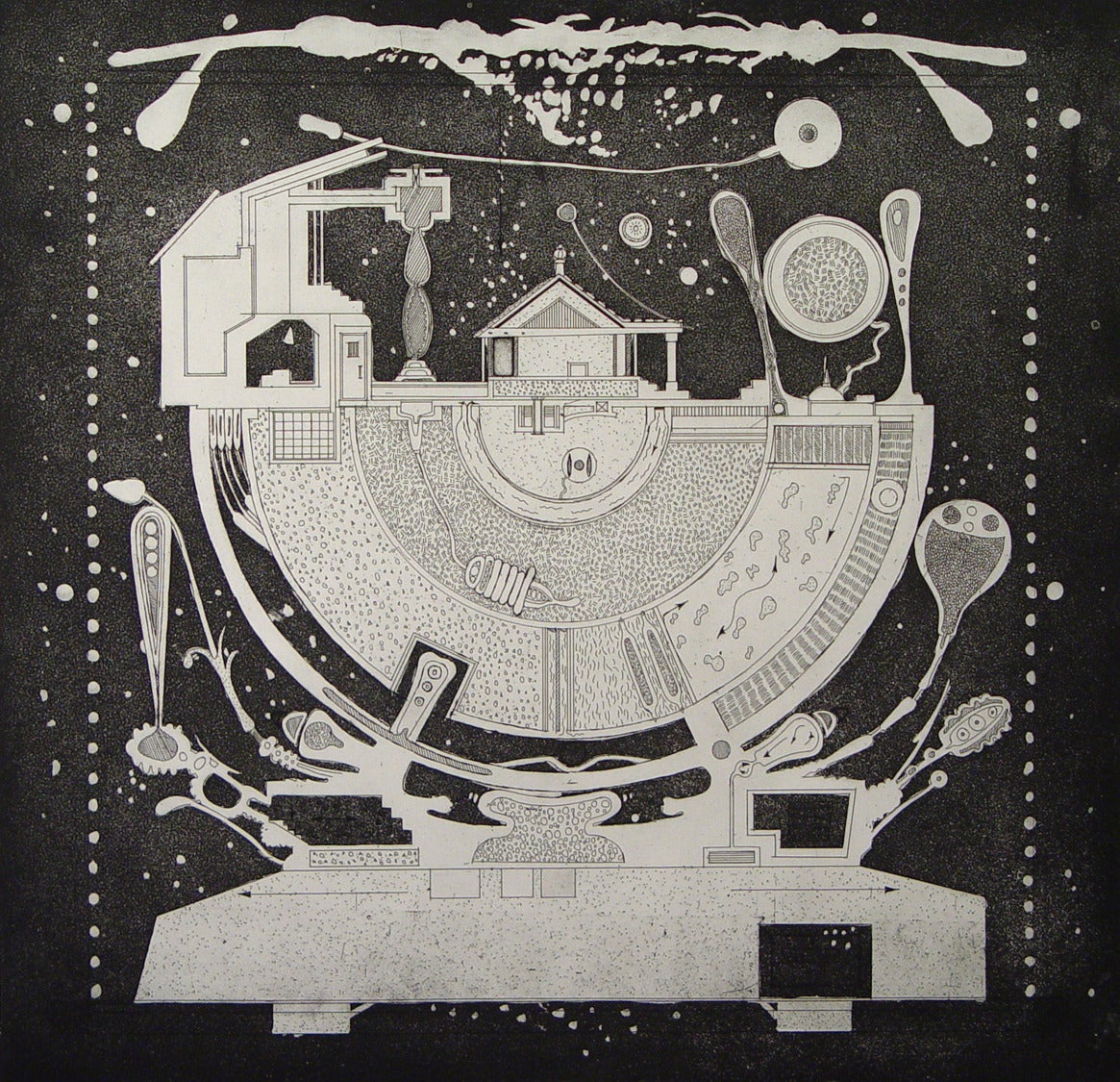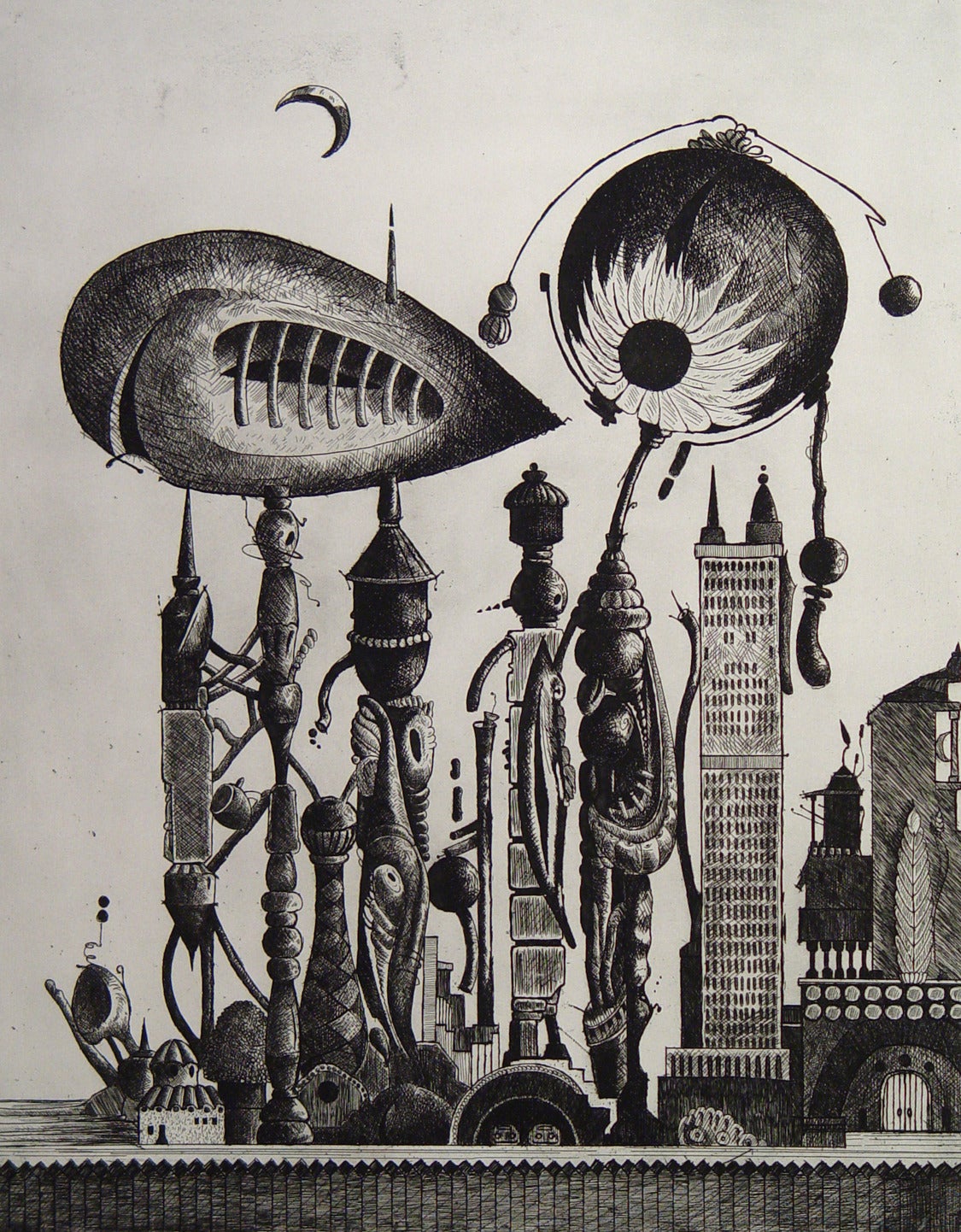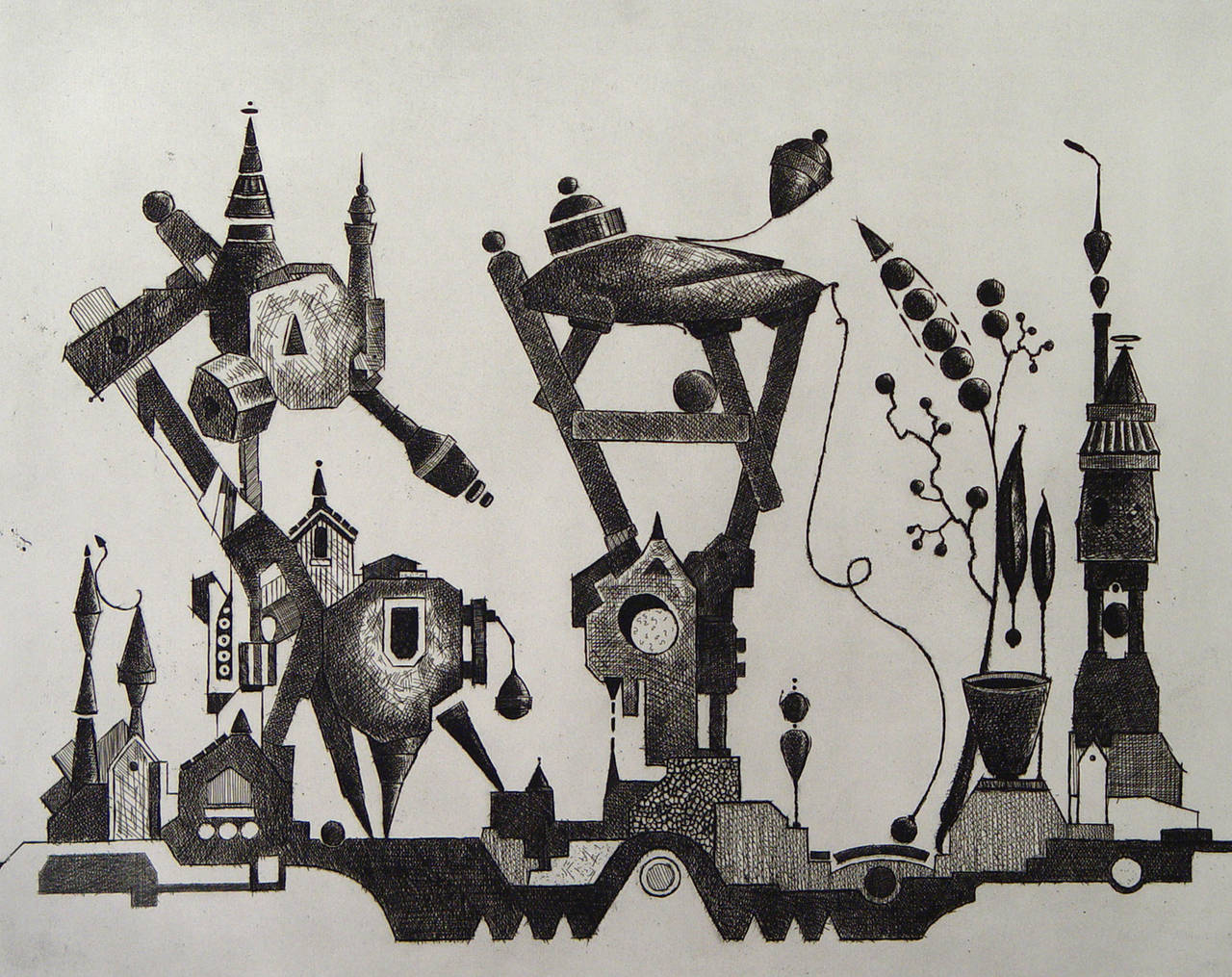Want more images or videos?
Request additional images or videos from the seller
1 of 5
Valton TylerDo Not Touch1970
1970
About the Item
In The New York Times Arts in America column, Edward M. Gomez wrote of Valton Tyler, "visionary seems the right word for describing his vivid, unusual and technically refined paintings, prints and drawings, whose style defies convenient labels. Abstract, surreal, cartoonish, sci-fi fantastic, metaphysical, apocalyptic-Baroque - all of these fit but also fall short of fully describing his art." (The Living Arts, June 13, 2000, p. B2)
Valton Tyler was born in 1944 in Texas, where "the industrial world of oil refineries made a long-lasting impression on Valton as a very young child living in Texas City. He was three years old when the terrible explosion occurred there and can remember the terrifying confusion and 'the beautiful red sky and objects flying everywhere in the air.'" (Reynolds, p. 25) While growing up in Texas City, Valton's father worked in auto repair, and was known for his skill in mixing colors for paint jobs. After leaving Texas City, Valton made his way to Dallas, where he briefly enrolled at the Dallas Art Institute, but found it to be too social and commercial for his taste. After Valton's work was introduced to Donald Vogel (founder of Valley House Gallery), "Vogel arranged for Tyler to use the printmaking facilities in the art department of the Southern Methodist University in Dallas, where the young artist essentially taught himself several demanding printmaking techniques. 'It was remarkable,' Vogel says. 'Not only did he learn complicated etching methods, but he was able to express himself powerfully in whatever medium he explored.' Vogel became the publisher of Tyler's prints. Among them, the artist made editions of some 50 different images whose sometimes stringy abstract forms and more solid, architecturally arresting elements became the precursors of his later, mature style." (Gomez, Raw Vision #35, p. 36)
“Do Not Touch” is plate number 20, and is reproduced in "The First Fifty Prints: Valton Tyler" with text by Rebecca Reynolds, published for Valley House Gallery by Southern Methodist University Press, Dallas, Texas, 1972.
In “The First Fifty Prints,” Reynolds wrote, “An understanding of the technical methods used in this plate is important in discussing the purpose of this design. As Mr. Scholder has described the process, Valton first draws an outline of the design with felt pen on tracing paper. This outline is then transferred onto the plate. The next stage in this case was to cover the areas which are white in the finished print with stop-out varnish and to spray the exposed areas with spray paint. When the plate is immersed in an acid solution, only the tiny spots not protected with the paint are bitten. Through this use of aquatint, Valton achieved the fuzzy texture of the black background. Returning to the design, overlaid with hard ground, he then scratched in the patterning of the lines. Hard ground was again applied to protect the finished background, the plate was again submerged in the acid, and the lines were then etched.”
Reynolds continues, “The order of these technical stages and the resulting white silhouette against a black ground create an X-ray view, or negative, that focuses on what Valton feels is the backbone of his designs. The patterns of simple parallel lines we see here are the only elements that model, define, and animate the forms, and not the use of contour line. He has intended to diagram and emphasize in this plate the role his line performs and the magic it creates when further developed in such intricate plates as “Heritage,” Plate No. 25, “Together We Are,” Plate No. 27, and “A New Born Day,” Plate No. 50.” (Reynolds, p. 76)
Paper size: 21 1/4 x 23 inches
Edition: 5 Artists Proofs Imp. 50 Signed Prints Imp.
Bibliography:
Edward M. Gomez, "Futuristic Forms Frolic Under Eerie Texan Skies," The New York Times, June 13, 2000, page B2.
Edward M. Gomez, "Valton Tyler's Techno-Organic Landscapes," Raw Vision 35, Summer 2001, pages 34-39.
Rebecca Reynolds, "The First Fifty Prints: Valton Tyler," published for Valley House Gallery by Southern Methodist University Press, Dallas, Texas, 1972.
- Creator:Valton Tyler (1944, American)
- Creation Year:1970
- Dimensions:Height: 15.75 in (40.01 cm)Width: 17.75 in (45.09 cm)
- Medium:
- Movement & Style:
- Period:
- Condition:
- Gallery Location:Dallas, TX
- Reference Number:
About the Seller
5.0
Recognized Seller
These prestigious sellers are industry leaders and represent the highest echelon for item quality and design.
Established in 1954
1stDibs seller since 2013
151 sales on 1stDibs
Typical response time: A week
Associations
Art Dealers Association of America
- ShippingRetrieving quote...Ships From: Dallas, TX
- Return PolicyA return for this item may be initiated within 2 days of delivery.
More From This SellerView All
- Just a Little Water PleaseBy Valton TylerLocated in Dallas, TXIn The New York Times Arts in America column, Edward M. Gomez wrote of Valton Tyler, "visionary seems the right word for describing his vivid, unusual and technically refined paintin...Category
1960s Outsider Art Abstract Prints
MaterialsRag Paper, Etching, Aquatint
- HeritageBy Valton TylerLocated in Dallas, TXIn The New York Times Arts in America column, Edward M. Gomez wrote of Valton Tyler, "visionary seems the right word for describing his vivid, unusual and technically refined paintin...Category
1960s Outsider Art Abstract Prints
MaterialsRag Paper, Etching, Aquatint
- World of WatermelonsBy Valton TylerLocated in Dallas, TXIn The New York Times Arts in America column, Edward M. Gomez wrote of Valton Tyler, "visionary seems the right word for describing his vivid, unusual and technically refined paintings, prints and drawings, whose style defies convenient labels. Abstract, surreal, cartoonish, sci-fi fantastic, metaphysical, apocalyptic-Baroque - all of these fit but also fall short of fully describing his art." (The Living Arts, June 13, 2000, p. B2) Valton Tyler was born in 1944 in Texas, where "the industrial world of oil refineries made a long-lasting impression on Valton as a very young child living in Texas City. He was three years old when the terrible explosion occurred there and can remember the terrifying confusion and 'the beautiful red sky and objects flying everywhere in the air.'" (Reynolds, p. 25) While growing up in Texas City, Valton's father worked in auto repair, and was known for his skill in mixing colors for paint jobs. After leaving Texas City, Valton made his way to Dallas, where he briefly enrolled at the Dallas Art Institute, but found it to be too social and commercial for his taste. After Valton's work was introduced to Donald Vogel (founder of Valley House Gallery), "Vogel arranged for Tyler to use the printmaking facilities in the art department of the Southern Methodist University in Dallas, where the young artist essentially taught himself several demanding printmaking techniques. 'It was remarkable,' Vogel says. 'Not only did he learn complicated etching methods, but he was able to express himself powerfully in whatever medium he explored.' Vogel became the publisher of Tyler's prints. Among them, the artist made editions of some 50 different images whose sometimes stringy abstract forms and more solid, architecturally arresting elements became the precursors of his later, mature style." (Gomez, Raw Vision #35, p. 36) “World of Watermelons” is plate number 19, and is reproduced in "The First Fifty Prints: Valton Tyler" with text by Rebecca Reynolds, published for Valley House Gallery by Southern Methodist University Press, Dallas, Texas, 1972. Of “World of Watermelons”, Tyler said “The title here does not represent my own associations with this print. Friends simply began referring to it as ‘the watermelon print...Category
1970s Outsider Art Abstract Prints
MaterialsRag Paper, Etching, Aquatint
- Height Almost 34'By Valton TylerLocated in Dallas, TXIn The New York Times Arts in America column, Edward M. Gomez wrote of Valton Tyler, "visionary seems the right word for describing his vivid, unusual and technically refined paintings, prints and drawings, whose style defies convenient labels. Abstract, surreal, cartoonish, sci-fi fantastic, metaphysical, apocalyptic-Baroque - all of these fit but also fall short of fully describing his art." (The Living Arts, June 13, 2000, p. B2) Valton Tyler was born in 1944 in Texas, where "the industrial world of oil refineries made a long-lasting impression on Valton as a very young child living in Texas City. He was three years old when the terrible explosion occurred there and can remember the terrifying confusion and 'the beautiful red sky and objects flying everywhere in the air.'" (Reynolds, p. 25) While growing up in Texas City, Valton's father worked in auto repair, and was known for his skill in mixing colors for paint jobs. After leaving Texas City, Valton made his way to Dallas, where he briefly enrolled at the Dallas Art Institute, but found it to be too social and commercial for his taste. After Valton's work was introduced to Donald Vogel (founder of Valley House Gallery), "Vogel arranged for Tyler to use the printmaking facilities in the art department of the Southern Methodist University in Dallas, where the young artist essentially taught himself several demanding printmaking techniques. 'It was remarkable,' Vogel says. 'Not only did he learn complicated etching methods, but he was able to express himself powerfully in whatever medium he explored.' Vogel became the publisher of Tyler's prints. Among them, the artist made editions of some 50 different images whose sometimes stringy abstract forms and more solid, architecturally arresting elements became the precursors of his later, mature style." (Gomez, Raw Vision #35, p. 36) “Height...Category
1970s Outsider Art Abstract Prints
MaterialsRag Paper, Aquatint
- Avenue 11By Valton TylerLocated in Dallas, TXIn The New York Times Arts in America column, Edward M. Gomez wrote of Valton Tyler, "visionary seems the right word for describing his vivid, unusual and technically refined paintin...Category
1960s Outsider Art Abstract Prints
MaterialsRag Paper, Etching
- Stop Playing and Get to WorkBy Valton TylerLocated in Dallas, TXIn The New York Times Arts in America column, Edward M. Gomez wrote of Valton Tyler, "visionary seems the right word for describing his vivid, unusual and technically refined paintin...Category
1960s Outsider Art Abstract Prints
MaterialsRag Paper, Etching
You May Also Like
- The Gun, intaglio print from copper plate, chine-collé with Japanese paperLocated in Toronto, OntarioTHE GUN by Rocky Dobey is an intaglio print from an acid-etched copper plate, chine-collé with Japanese paper on archival Hahnemuhle paper, mounted...Category
21st Century and Contemporary Outsider Art Figurative Prints
MaterialsGlass, Paint, Archival Paper, Handmade Paper, Engraving, Etching, Intaglio
- "BROKEN MIRROR 03242018 607pm", Primitive, Digital Print, Flag, Purple, RedBy Justin NeelyLocated in Toronto, OntarioThe abstract print "BROKEN MIRROR 03242018 607pm" is a digital artwork, created with the Brushes Redux iPhone app, and printed at 36x36" on museum-quality Canson Platine Fibre Rag 310gsm archival paper. As the title indicates, the artwork was created on March 24, 2018 at 6:07 pm. While Justin Neely...Category
21st Century and Contemporary Outsider Art Abstract Prints
MaterialsArchival Pigment, Digital Pigment, Archival Paper
- Large 1960s French Art Brut Lithograph Bold Black & White Op Art Philippe DereuxLocated in Surfside, FLprinted by Pierre Chave, Vence, published by Bianchi Frères in Nice, France ink on watermarked chiffon de Mandeure paper, hand signed in pencil lower right, "PH Dureux," numbered 4/5...Category
1960s Outsider Art Abstract Prints
MaterialsArchival Paper, Lithograph
- Large 1960s French Art Brut Lithograph Bold Black & White Op Art Philippe DereuxLocated in Surfside, FLPrinted by Pierre Chave, Vence, published by Bianchi Frères in Nice, France ink on watermarked chiffon de Mandeure paper, hand signed in pencil lower right, "PH Dureux," numbered 4/50 lower left, titled in pencil center. This might be a silkscreen or lithograph technique. Philippe Dereux was a French artist, born in Lyon in 1918, he was a teacher by profession. Widely known and appreciated for his abstract and decorative collages based on fruit and vegetable peelings. His work was featured in exhibitions at the Collection de l'Art Brut and the Halle Saint Pierre. He was a collaborator of Jean Dubuffet in Vence in the mid-1950s, later going out on his own around 1960. Dereux's works are covered with plant elements (fruits or vegetable peels, flora and fauna). Abstract and decorative works in which he incorporated peelings of fruits, eggplants or potatoes glued with vinyl glue on cardboard and colored with gouache. He also made butterfly wing collage and assemblage works. His work, while boldly unique, bears many influences Art Brut, Outsider art, Enrico Baj, Aboriginal art, Tribal art, These works bear the influence of the black & white Op Zebra Art of Victor Vasarely and Yaacov Agam (He was collected and showed with Alphonse Chave. An art lover, dealer and collector. On November 15, 1947 in Vence, under the name Les Mages, he opened a contemporary art gallery which would also become a high place of art brut, Naive and unique art. The gallery took its final name - Galerie Alphonse Chave - in 1960. He exhibited Dado, Philippe Dereux, Jean Dubuffet, Max Ernst, Henri michaux, Louis Pons, Man ray, Dorothea Tanning, Zao Wou-ki as well as other creators.) Many public exhibitions were dedicated to him during his lifetime in Vence , Lyon , Grenoble and Paris : 1964: Fifty years of collages , Musée de Saint-Étienne, Musée des arts décoratifs de Paris. 1968: Living art, Fondation Maeght . 1984: Musée des arts décoratifs de Paris. 1985: Flaine Art Center. 1997: Neuve Invention Musée de l'art brut de Lausanne. 1999: Villefranche sur Saône cultural center and events in London and New York. 2003: Halle Saint-Pierre, Paris. Exhibitions at the Galerie Alphonse Chave in Vence: 1965: The peeling work 1968: Pure peelings, trimmed peels , paintings, lithographs. 1972: High Tension 1981-1983: XX years of peelings 1989: Theaters of peeling . 1994: The little treatise on peelings 1999: One life 2007: Retrospective of works from 1960 to 2000 2009: Exhibition Dereux / Dubuffet, Museum of Fine Arts of Lyon 2012: Philippe Dereux (1918-2001). Memories of peelings, Chave gallery, Vence. The retrospective is made up of Dereux's personal collection, many of which have never been shown. There are more than one hundred and forty works exhibited. 2014: Le Mur, works by Philippe Dereux exhibited, with the 1200 works from the Antoine de Galbert collection at La Maison rouge...Category
1960s Outsider Art Abstract Prints
MaterialsArchival Paper, Lithograph
- Large 1960s French Art Brut Lithograph Bold Black & White Op Art Philippe DereuxLocated in Surfside, FLPrinted by Pierre Chave, Vence, published by Bianchi Frères in Nice, France ink on watermarked chiffon de Mandeure paper, hand signed in pencil lower right, "PH Dureux," numbered 4/5...Category
1960s Outsider Art Abstract Prints
MaterialsArchival Paper, Lithograph
- Large 1960s French Art Brut Lithograph Bold Black & White Op Art Philippe DereuxLocated in Surfside, FLPrinted by Pierre Chave, Vence, published by Bianchi Frères in Nice, France ink on watermarked chiffon de Mandeure paper, hand signed in pencil lower right, "PH Dureux," numbered 4/5...Category
1960s Outsider Art Abstract Prints
MaterialsArchival Paper, Lithograph
Recently Viewed
View AllMore Ways To Browse
Spray Paint Vintage
Oil Paintings Signed Reynolds
Black And White Baroque Art
Vintage Spray Paint Cans
Vintage Spray Paint Can
Retro Auto Art
Vintage Auto Prints
Vintage Flying Models
Vintage Diagrams
Fuzzy Art
Reynolds Etching
Vintage Technical Pen
Sci Fi Oil Painting
Retro Futuristic Paintings
White Fuzzy
Acid Etched Painting
Retro Futuristic Elements
Mr Ray





